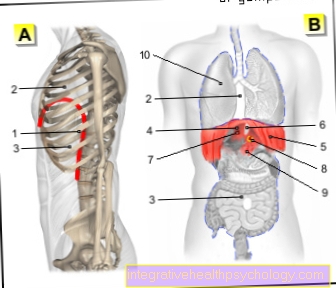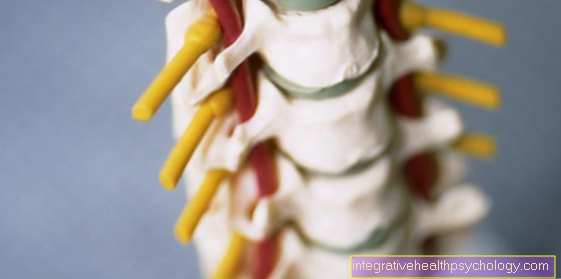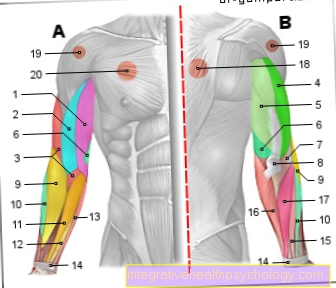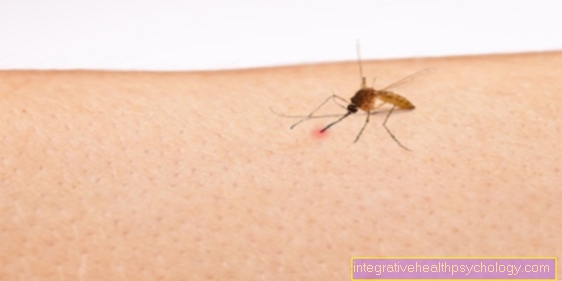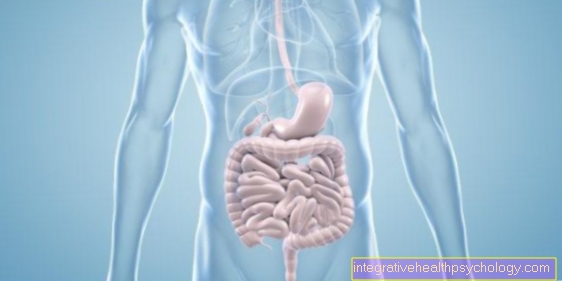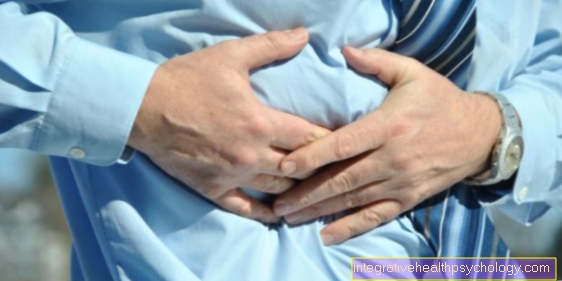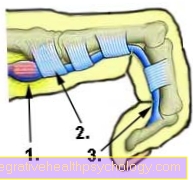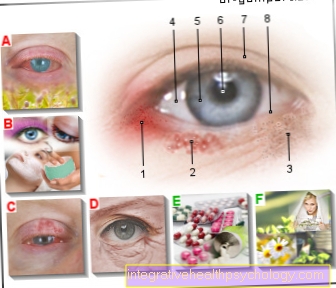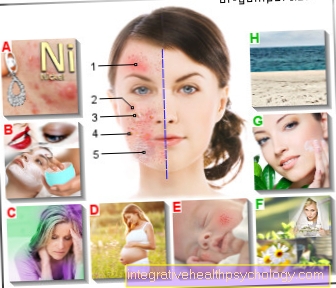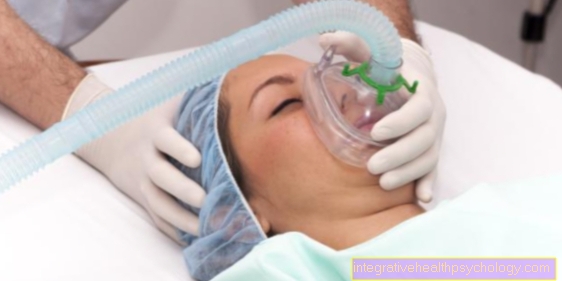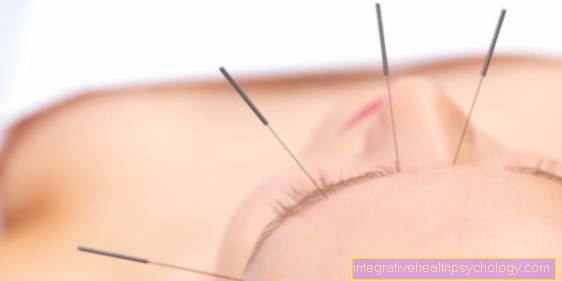Phlebitis in the arm
What is phlebitis in the arm?
An inflammation of the veins in the arm, also called phlebitis, is inflammation of the venous blood vessels. The inflammation usually occurs locally and leads in particular to inflammation of the vein wall.
Phlebitis can occur on the arms as well as on the legs. Phlebitis is also differentiated based on the location of the veins - superficial veins as well as deeper veins can be affected. The location of the inflamed vessel provides information about the cause of the inflammation. The cause can be, for example, an injury to a superficial blood vessel, which causes harmless inflammation. However, a thrombosis of the deeper vein can trigger serious inflammation, which should be clarified by a doctor.

The symptoms
The symptoms of phlebitis on the arm are very diverse and can vary in severity. The phlebitis is often noticeable because it causes pain in the affected area. Most of the time, the pain increases as soon as pressure is applied to the area. The skin can also tighten over the affected area.
The inflammatory reaction usually leads to reddening of the skin. If a superficial arm vein is affected by the inflammation, the redness can even be observed along the course of the vein. In addition, overheating of the skin can occur. If you put your hand on the affected area, you can feel a clear temperature difference to the surrounding skin.
If the phlebitis occurs as a result of varicose veins, the vein itself appears swollen and thickened. Sometimes small nodules can also be seen in the course of such a vein.
Read more on this topic: Symptoms of phlebitis.
The reasons
The causes of a phlebitis on the arm can be very diverse. It can be a spatially limited, harmless inflammation. However, thrombosis can also develop, which can lead to serious complications.
If an inflammation of the arm vein occurs, the trigger can be a medical intervention, for example. This includes, for example, taking blood, but also inserting a so-called vascular access (for example an indwelling venous cannula), which is placed through the vein to give an infusion. With these punctures, germs can be carried over by inserting a vascular access. These germs lead to a local inflammatory reaction. But the infusion itself, which flows into the vein via the vascular access, can cause inflammation, as it irritates the vein wall.
In addition, thrombosis should not be ruled out. The cause of this can, for example, be a bacterial inflammation of the arm vein. If there are varicose veins on the arms, the risk of developing a thrombosis is significantly increased.
Find out more about the topic here: The thrombosis.
The infusion / blood draw as a possible cause
Phlebitis on the arm can be triggered, among other things, by medical interventions. These are mainly inlays for vascular access, such as indwelling venous cannulas or puncture needles (for taking blood). In order to create these vascular accesses, the skin must be pierced. This leads to a small, spatially limited injury to the skin.
Germs can now be carried through this puncture into the vessel and cause an inflammatory reaction. To prevent this, however, the skin should be thoroughly disinfected and only sterile material should be used. Despite these precautionary measures, germs can spread. The inflammation is then expressed by reddened and overheated skin, which can also burn.
If the inflammation is mild with mild symptoms, the inflammation will heal within a few days. However, bacterial thrombosis can also develop, which can then lead to serious complications.
Read more on this topic at: Phlebitis after an infusion
Chemotherapy as a possible cause
Phlebitis on the arm can also be caused by the administration of chemotherapeutic agents through a vascular access (e.g. indwelling venous cannula).
If a vascular access is made, a thin plastic tube of the intravenous cannula remains in the vessel. Medicines such as chemotherapeutic agents can then be given in the form of an infusion via this access. Since these are very powerful drugs, they can irritate the vein wall. This can cause the vein wall to swell and become red.
However, the reaction cannot be prevented if the chemotherapy drug has to be given through a vein. If the pain is severe, an alternative vascular access, such as a port, may be considered for some patients, in which the irritation of the vessel is often less.
Read more on the topic: The side effects of chemotherapy drugs.
The insect bite as a possible cause
An insect bite on the arm can cause an inflammatory reaction that also affects the veins. An insect bite injures the skin. In addition, there is an allergic reaction of the skin around the puncture site, which is also noticeable in an inflammatory reaction. Bacteria can now get into the vessel through the bite. The body tries to fight these pathogens and releases messenger substances that trigger inflammation. The skin becomes swollen, overheated and reddened. Itching may also occur in some cases.
Most of the time, an insect bite triggers a harmless inflammation of the vein that is only limited to the puncture site.
Inflamed insect bite - what to do? Find out more about this here.
The diagnosis
A visual diagnosis is often enough to determine if there is a phlebitis on the arm. The skin is often painful and tight over the affected area. In addition, symptoms such as redness and swelling usually occur. In addition, the veins can also be visualized with the help of an ultrasound in order to clearly identify the inflammation.
Another method that is suitable for making a diagnosis is so-called duplex sonography of the veins. This examination method is painless, non-invasive and without radiation exposure. It shows the blood flow within the veins and can, for example, show whether there is a thrombosis in a vessel.
The treatment
The treatment of arm vein inflammation differs depending on the underlying disease or trigger. If the cause is the creation of a vascular access, such as the indwelling venous cannula, this should be removed and, if possible, punctured at a different point. The puncture for a blood sample should also be done at a different location if possible, otherwise the irritation of the vein can increase. The symptoms usually subside relatively quickly.
The area can be cooled to help relieve the pain. An anti-inflammatory ointment can also be applied if necessary. As an active ingredient, ointments with drugs from the group of so-called non-steroidal anti-inflammatory drugs, for example with the active ingredient diclofenac, are particularly suitable.
If there is a bacterial infection of the skin, it can be treated with antibiotics. If the phlebitis leads to the formation of a thrombus (blood clot), the treatment is much more extensive. Medicines are used to prevent the blood from clotting, such as heparin. Treatment is usually tied to hospitalization, as it includes further therapeutic measures.
Find out all about the topic here: Treatment of phlebitis.
The duration
The phlebitis usually heals within a few days of the diagnosis. It is important to identify the cause early on and treat it. If a vascular access is responsible for the inflammation, the symptoms usually subside 1-2 days after the access has been removed. Supportive measures such as cooling the skin area or applying anti-inflammatory ointments to the skin can further shorten the duration of the inflammation.
Bacterial infections of the veins can also be treated quickly and reliably with the help of antibiotics and will subside after a few days. No further complications or restrictions are to be expected afterwards.
If there is an arm vein thrombosis as a result of phlebitis, the patient often has to be hospitalized. The duration then depends on the severity of the thrombosis and possible complications. If the treatment is carried out quickly and there are no other illnesses, a rapid improvement of the symptoms can also be observed here.
Read more about Duration of a phlebitis
The course of the disease
The phlebitis in the arm should be treated as quickly as possible as soon as the first symptoms appear. In this case, the course of the disease is favorable. If the inflammation is additionally cooled and creamed with ointments, the healing process can be accelerated. However, if there is no improvement in the symptoms, further possible causes should be clarified.
The course of an arm vein thrombosis depends mainly on the time of diagnosis. If this is set quickly, the therapy can be initiated immediately. Basically, there is a risk of embolism with a thrombosis. This can cause serious complications, such as a pulmonary embolism. However, this complication rarely occurs with phlebitis of the arm.
Read more on the subject here: The embolism.
It can be that dangerous
Phlebitis of the arm is usually not dangerous. Inflammation of the superficial veins in particular is usually a spatially limited inflammatory reaction that can be treated quickly. Once the symptoms have subsided, no further complications are to be expected.
With an arm vein thrombosis, however, there is a risk of pulmonary embolism. The thrombus (blood clot) can be transported by the bloodstream from the arm vein to the heart and from there to the lungs. There the thrombus can clog the blood vessels, which can lead to a life-threatening situation.
Find out all about the topic here: The pulmonary embolism.
The thrombosis
In general, there is a risk of thrombosis in the case of arm vein inflammation. However, this is very rare compared to leg vein thrombosis.Thrombosis is when a blood clot blocks a blood vessel.
A thrombus can develop for various reasons. These causes can be, for example, a coagulation disorder, slow blood flow or bacterial inflammation. If the thrombus clogs a blood vessel, a local reaction such as swelling and tenderness occurs there.
A particular danger of thrombosis is that the thrombus can loosen and be transported further with the blood flow. If it gets into a lung vessel and blocks it, a pulmonary embolism can occur. A pulmonary embolism is a life-threatening situation and must be treated as quickly as possible, otherwise the lung tissue can die.
Also read the article: Recognize a thrombosis.










